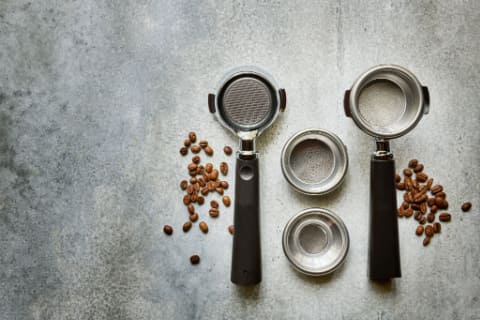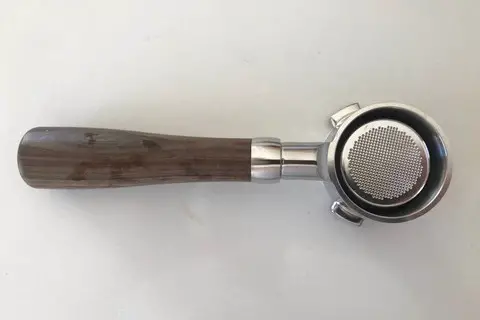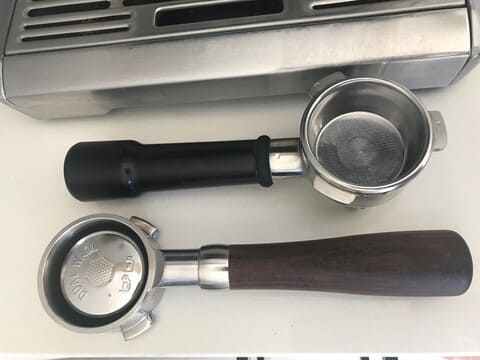As an Amazon Associate I earn from qualifying purchases. When you use our links, we may earn an affiliate commission. Learn more.
When you finally get your hands on the perfect espresso machine, you need the right portafilter basket to take your coffee experience to new heights. The only problem is, portafilter baskets come in a wide range of styles and sizes so choosing one can be confusing.
Granted, filter baskets may look all too similar to tell them apart, even up close, but the differences in performance will definitely hit you like a ton of bricks. If you want to learn more about portafilter basket types, this article is for you!
There you have it, a full guide explaining portafilter basket types and how you can tell them apart.
Choosing the right size and shape of your filter basket isn’t enough to make great-tasting espresso, it also needs to carry smooth, even holes to ensure a consistently strong shot.
Finally, here’s a really useful guide if you want to learn how to clean portafilter baskets between shots.
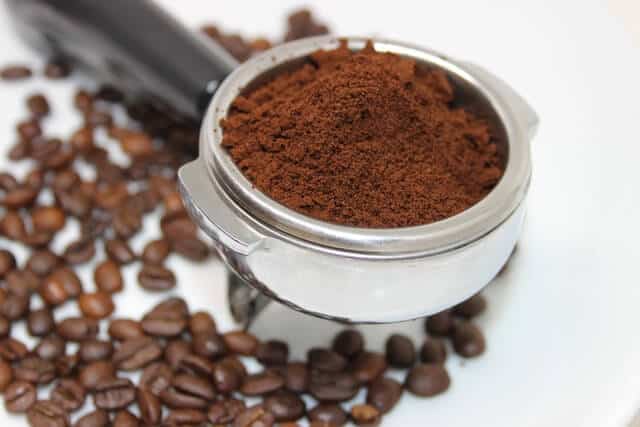
What is a Portafilter Basket?

If you’re a newcomer to the world of coffee making, you’re probably wondering what a portafilter basket is and what it does. A portafilter basket is a metal filter with a pretty simple job, and that’s to trap coffee grounds when you’re pulling an espresso shot.
The portafilter basket is specially designed to be used with the ultra-fine coffee grind size of espresso. It’s also built to withstand being under high pressure.
In theory, filtering coffee grounds out of your coffee should be easy. But that’s only if the coffee particles had the exact same size, which unfortunately is not the case.
On a microscopic scale, coffee particles differ greatly in shape and size. Yet this variation is one of the reasons espresso tastes the way it does.
Particles that are smaller than the basket holes will easily slip through the metal filter and into your cup, producing the thick, rich espresso we all crave. Up to this point, everything is fine. The trouble begins when the slightly larger particles than the basket holes come into the picture.
It just takes a particle of the wrong size or shapes to clog a hole, which wouldn’t be an issue if it was only that one. Most likely, a bunch of openings will be obstructed at the same time during extraction (which may even trigger a domino effect on the holes around them).
These obstructions will then cause under-extraction of the grounds being them since less water will be able to flow through. As a result, you’ll end up with weak shots.
How can you prevent clogging the portafilter basket? Well, since the consistency of the holes’ shape and size has the biggest impact on the clogging chances, your solution would be to purchase a high-quality portafilter basket.
Low-quality filter baskets have holes that are sharp, jagged, and uneven. So the chances of coffee particles getting stuck in them are far higher. There’s just less risk of clogging with a smooth, perfectly circular hole.
If you’d like to learn more about the differences between a portafilter and a basket, check out my portafilter vs. basket guide.
Espresso Basket Types
Single, Double, and Triple Filter Portafilter Baskets
The ‘single, double, and triple’ naming simply refers to the number of espresso shots you can pull using this particular basket, most commonly, one or two. To put it simply, a bigger portafilter basket will yield more espresso.
Single Portafilter Basket – this type of basket can hold about 7 to 12 grams of ground coffee, so it makes one shot of espresso. With a funnel-shaped body that’s typically used on a single-spouted portafilter, you can easily identify single filter baskets from other basket types.
Double Portafilter Basket – this basket can hold between 14 and 21 grams. It has straight or slightly tapered walls.
Triple Portafilter Basket – any basket that can hold more than 21 grams of coffee grounds is called a triple. The capacity is just about the only real difference between a double and a triple basket since you can use both to make double espressos.
Keep in mind that triple portafilter baskets may not be compatible with your portafilter because they’re deeper than the regular double filter basket. This means you’ll need a deeper portafilter to use triple baskets.
Ridged Portafilter Basket
Here’s another one that’s easy to identify – ridged portafilter baskets. Look near the top of the basket, if you find an indentation that extends along its entire circumference, then you got yourself a ridged-type portafilter basket.
The purpose of this ridge is to keep the basket secure in its place inside the portafilter during extraction.
Ridgeless filter baskets
On the other hand, a ridgeless basket lacks the indentation we mentioned above. As a result, there’s always a risk that the basket will accidentally get knocked out of the portafilter.
Despite this disadvantage, ridgeless baskets are known for offering cleaner extraction than their ridged counterparts. The reason is the tendency of old coffee grinds to accumulate in the ridge area.
Pressurized Dual-Wall Filter Baskets
The term ‘dual-wall’ refers to when a portafilter basket features a false bottom. This means that if you look from the top, you’ll see a wall that’s different from the one you’ll see if you look from the bottom.
Dual-wall filter baskets are exclusively present in espresso machines built for home use. They help people produce fake crema from pre-ground coffee by pressurizing the already extracted coffee through a second wall with a tiny hole at the bottom.
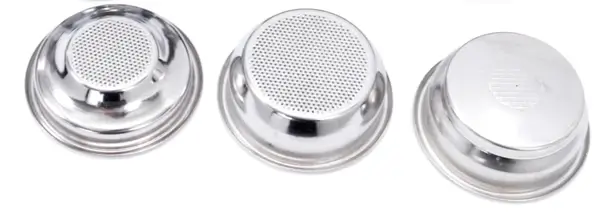
Source: wholelattelove.com
However, if you can afford it, it’s best to invest in a proper coffee grinder for your home. Grinding your own beans fresh makes for a phenomenal cup of coffee.
Precision filter baskets
Last but not least, we have precision filter portafilter baskets. These babies can be described in one word: consistency.
That’s right, these baskets feature evenly sized filtration holes, which as we said before, is how you can prevent clogging of the basket. These are the higher-quality baskets we mentioned then.
Lower-quality or cheap portafilter baskets are made using basic manufacturing techniques that result in irregular sizing of hole diameter, or even worse, partially and fully blocked filter holes. As you can expect, these manufacturing defects will often give you an under-extracted, weak espresso shot.
This free cheat sheet will improve your coffee brew by providing quick information on brew ratio, grind size, optimal brewing time, and more.
Wrap Up
There you have it, a full guide explaining portafilter basket types and how you can tell them apart. Choosing the right size and shape of your filter basket isn’t enough to make great-tasting espresso, it also needs to carry smooth, even holes to ensure a consistently strong shot.
Brooke Davis
Hi everyone, my name is Brooke and I’m a Barista and freelance writer. I love brewing coffee and my favorite coffee drink is without doubt an Americano (espresso with added hot water). When I’m not busy making or writing about coffee you’ll find me hanging out at the beach with friends in California where I am currently residing. Follow me on: LinkedinThis free cheat sheet will improve your coffee brew by providing quick information on brew ratio, grind size, optimal brewing time, and more.
